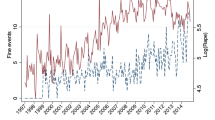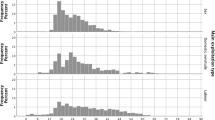Abstract
Much has been written about sex trafficking in the past decade, although empirical studies have remained few. Even less research has been done on those who make a living by facilitating the movement of women and children in the sex industry. This paper is based on a three-year study in Tijuana, Mexico, in which 92 sex trade facilitators were interviewed. Findings suggest a far more complex social process than portrayed by the anti-trafficking literature. Men and women of diverse backgrounds developed niches in Tijuana’s sex industry, by bringing women into contact with customers. This business appeared to be dominated by Mexican entrepreneurs, with no evidence of any systematic collaborations with either local criminal organizations or foreign traffickers. There appeared to be no shortage of women willing to work in the sex industry, suggesting limited prospect for coerced prostitution. Still, a small number of pimps reported using “persuasion” to recruit women of particular types from interior Mexico. Commissions or referral fees were the most common form of income received by pimps for their services, and the rules on how money was to be made and split between sex workers and venue owners appeared well established. While a few respondents could sustain a livelihood through pimping, the majority held other jobs.
Similar content being viewed by others
Notes
A total of 124 nations have signed the UN anti-trafficking protocol, as of 26/09/2008, the latest available data posted on the United Nations website: http://www.unodc.org/unodc/en/treaties/CTOC/countrylist-traffickingprotocol.html.
References
Bales, K. (1999). Disposable people: New slavery in the global economy. Berkeley: University of California Press.
Bales, K. (2005). Understanding global slavery: A reader. Berkeley, CA: University of California Press.
Bales, K., & Lize, S. (2005). Trafficking in persons in the United States. A report to the National Institute of Justice. University, MS: University of Mississippi, Croft Institute for International Studies.
Castillo, D. A., Gomez, M. G. R., & Delgado, B. (1999). Border lives: Prostitute women in Tijuana. Journal of Women in Culture and Society, 24(2), 387–442.
Cearley, A. (2004). Tijuana tries to move sex trade out of public eye. Copley News Service, October 11. http://web.lexis-nexis.com. Accessed 25 May 2011.
Day, S. (2009). Renewing the war on prostitution: The specters of ‘trafficking’ and ‘slavery. Anthropology Today, 25(3), 1–3.
Estes, R.J., & Weiner, N.A. (2001). The commercial sexual exploitation of children in the U.S., Canada and Mexico. Philadelphia, PA: University of Pennsylvania, School of Social Work, Center for the Study of Youth Policy. Available at: http://www.sp2.upenn.edu/~restes/CSEC.htm.
Fetterman, D. M. (1995). Ethnography: Step by step. Applied social research method series volume 17. Thousand Oaks CA: Sage Publications.
Finckenauer, J. O. (2007). Mafia and organized crime: A beginner’s guide. Oxford, England: Oneworld Publishers.
Gambetta, D. (1993). The Sicilian mafia: The business of private protection. Cambridge, Mass.: Harvard University Press.
Gozdziak, E., & Bump, M. N. (2008). Data and research on human trafficking: Bibliography of research-based literature. A Final Report to NIJ Grant 2007-VT-BX-K002. Washington, D.C: Institute for the Study of International Migration, Georgetown University.
Kempadoo, K., & Doezema, J. (1998). Global sex workers: Rights, resistance, and redefinition. New York: Routledge.
Loewenberg, S. (2006). Fears of World Cup sex trafficking boom unfounded. The Lancet, 368(9530), 105–106.
Massey, D. S. (1987). The ethnosurvey in theory and practice. International Migration Review, 21, 1498–1522.
Massey, D. S. (1993). The methodology of an ethnosurvey. Chapter 24. In D. J. Bogue (Ed.), Readings in the methodology of population research. New York: United Nations Funds for Population Activities.
Massey, D. S., & Zenteno, R. (2000). A validation of the ethnosurvey: The case of Mexico-U.S. migration. International Migration Review, 34(3), 766–794.
Miko, F. T., & Park, G. (2002). Trafficking in women and children: The U.S. and international response. Washington, DC: The Library Congress, Congressional Research Service.
Raymond, J.G., & Hughes, D.M. (2001). Sex trafficking of women in the United States: International and domestic trends. Washington, D.C.: U.S. Department of Justice. http://www.ncjrs.gov/pdffiles1/nij/grants/187774.pdf. Accessed 25 May 2011.
Richter, M. (2010). The impact of the South African World Cup on sex work and human trafficking. A paper presented at Crime Reduction in South Africa Beyond 2010, an international conference organized by South Africa Institute for Security Studies, December 1–2, Johannesburg, South Africa.
Sanghera, J. (2005). Unpacking the trafficking discourse. In K. Kempandoo, J. Sanghera, & B. Pattanaik (Eds.), Trafficking and prostitution reconsidered: New perspectives on migration, sex work, and human rights (pp. 3–24). Boulder: Paradigm Publishers.
Spagat, E. (2005). Mexican border city of Tijuana tries to make prostitution safer. Associated Press. September 15. http://web.lexis-nexis.com. Accessed 15 September 2005.
Steinfatt, T. M. (2002). Working at the Bar: Sex work and health communication in Thailand. Westport, CT: Greenwood.
Ugarte, M. B., Zarate, L., & Farley, M. (2003). Prostitution and trafficking of women and children from Mexico to the United States. In M. Farley (Ed.), Prostitution, trafficking and traumatic stress (pp. 147–165). Binghampton, NY: Haworth Maltreatment & Trauma Press.
U.S. Immigration and Customs Enforcement. (2003). ICE agent testifies before Congress on Growing Threat of Human Trafficking. News Release, June 24. http://www.ice.gov/pi/news/newsreleases/.
U.S. Department of State. (2006). Fact sheet: Distinctions between human smuggling and human trafficking. http://www.state.gov/m/ds/hstcenter/90434.htm. Accessed 25 May 2011.
U.S. Department of State. (2006). Trafficking in Persons Report. Washington, D.C.: U.S. Department of State, Office to Monitor and Combat Trafficking in Persons. http://www.state.gov/g/tip/rls/.
Weitzer, R. (2005). Flawed theory and method in studies of prostitution. Violence Against Women, 11(7), 934–949.
Yin, R. K. (1994). A case study research design and methods (2nd ed.). Thousand Oaks California: Sage Publications.
Zhang, S. X. (2009). Beyond the ‘Natasha’ story: A review and critique of current research on sex trafficking. Global Crime, 10(3), 178–195.
Author information
Authors and Affiliations
Corresponding author
Additional information
Funding for this study was provided by a grant from the National Institute of Justice, Office of Justice Programs, United States Department of Justice. Points of view in this document are solely those of the author and do not necessarily represent the official position or policy of the United States Government.
Rights and permissions
About this article
Cite this article
Zhang, S.X. Woman pullers: pimping and sex trafficking in a Mexican Border City. Crime Law Soc Change 56, 509–528 (2011). https://doi.org/10.1007/s10611-011-9333-2
Published:
Issue Date:
DOI: https://doi.org/10.1007/s10611-011-9333-2




